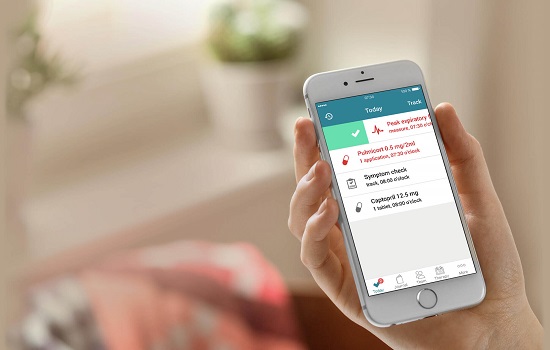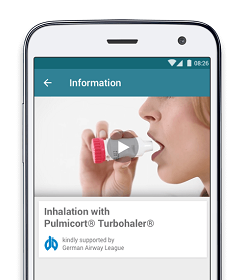When Asthma Attacks: Keep Your Asthma Under Control with a Smartphone App
Asthma Is a Chronic Condition That Requires Long-Term Treatment. Find out How MyTherapy Can Help You Control Your Asthma and Prevent Further Attacks

Asthma is a chronic lung condition that causes the airways to narrow, swell, and produce extra mucus. This causes coughing, wheezing, and shortness of breath. Asthma varies from person to person and for some, it can be a major problem that interferes with daily activities. There is currently no cure for asthma, but there are effective treatment options available. However, asthma does tend to change over time, so it is important that if you have asthma, you work closely with your doctor to track symptoms and triggers. You and your doctor will need to come up with an action plan to treat your asthma and it is important that you stick to this treatment plan as best as possible. Life is often busy, so remembering when or how to take medication can be challenging. Apps, like MyTherapy, can help you monitor and track your symptoms and triggers carefully and encourage you to stay on top of your treatment.
MyTherapy is a nifty medication management app that comes with a variety of features to help you follow through with your treatment plan. It is also designed to help you work closely with your doctor so that you can monitor the condition carefully and therefore get the best out your treatment plans. MyTherapy generates medication reminders, which specify when to use your inhaler and how many puffs to take, for example. This helps you relieve symptoms and prevent future asthma attacks. The app can also generate reminders for other medications (such as oral steroids), tell you about an upcoming doctor’s appointment, or remind you to use your peak flow meter. The reminder function therefore converts the challenging task of adhering to the action plan into a simple to-do list, which you can tick off as the day goes by. To upload your medication, all you have to do is scan the barcode of your medication packaging via the app’s built-in barcode scanner or search in the app’s database.
In addition to the reminder function, MyTherapy also comes with a digital asthma diary. This diary allows you to track your symptoms (e.g. breathlessness or chest tightness) and health measurements (e.g. peak flow meter value). It also allows you to document certain activities, such as exercise or animal contact. All the data that you log into the app is compiled into a monthly report, which you can give to your doctor. You and your doctor can review the information together to assess the effectiveness of the treatment plan, identify any obvious triggers or patterns leading to asthma attacks, and adjust the medication if necessary. The diary therefore makes it easy to monitor your condition in an effortless and paperless way.
When it comes to taking asthma medication, there are some important guidelines that you should follow, such as always ensuring you never run out of medication, understanding how your medications work, and knowing when and how to take your medication exactly as prescribed. MyTherapy helps you by not only reminding you to take your medication, but also by letting you know when you run low and need to buy more.
As MyTherapy is constantly being developed through user-feedback, the app is easy to understand and simple to use. It can offer valuable support to patients of every age, from children to adults. The app has also been clinically proven to improve medication adherence rates, so try it today for peace of mind about your health.
Asthma Is Caused by Inflamed and Narrowed Airways
Asthma is a chronic condition that affects the breathing passages of the lungs and is caused by the ongoing inflammation of these passages. The inflammation makes the airways swollen and sensitive, making breathing difficult. The airways tend to react strongly to certain inhaled substances. When the airways react to a trigger, the muscles around them tighten. This narrows the airways, resulting in restricted air flow into the lungs. Cells in the airways also produce more mucus than usual, which further narrows the airways. This chain reaction results in asthma symptoms.
The substances or triggers that may lead to the inflammation and narrowing of the airways include:
- Allergens (e.g. pollen, dust mites, animal fur, feathers)
- Medicines (e.g. aspirin, ibuprofen, beta-blockers)
- Certain foods (e.g. foods containing sulfites)
- Airborne irritants (e.g. cigarette smoke, chemical fumes, or air pollution)
- Respiratory tract infections (e.g. colds or flu)
- Weather conditions or indoor conditions
- Exercise
- Stress, laughing, or other emotions
In the UK, about 5.4 million people are currently receiving treatment for asthma. This equates to about one in every 12 adults and one in every 11 children. It can affect anyone, of any age, but it is more common in younger people.
Symptoms and Diagnosis
The symptoms of asthma vary from person to person. They can be mild and respond quickly to minimal treatment or they can continue to worsen. Usually the symptoms are worse during the night and early in the morning. Sometimes the symptoms also develop after a particular trigger (see above). The main symptoms include:
- Wheezing (a whistling sound while breathing)
- Shortness of breath
- A tight chest
- Coughing
In some cases, the symptoms become so intense that they cause an asthma attack or flare-up. If you experience an asthma attack, you will have a rapid heartbeat, feel exhausted and dizzy, and be too breathless to eat, speak, or sleep. It is also possible that the lips or fingers turn blue and the usual treatment will not relieve the symptoms like it usually does. If you or someone else is experiencing an asthma attack, it is important to seek medical help immediately.
If you think you (or your child) have asthma, you should go and visit your doctor. He or she will be able to make a diagnosis based on your medical history, a physical examination, and various test results. A common test to diagnose asthma is a spirometry. This measures a) the volume of air you can breathe out in the first second of exhalation and b) the total volume of air you can breathe out. Moreover, you may also perform a peak expiratory flow test with a small handheld device called a peak flow meter. The peak flow meter measures how fast you can blow air out of the lungs in one breath. Other tests may be performed to check whether other diseases (e.g. reflux disease, vocal cord dysfunction, sleep apnea) or foreign objects may be causing the same symptoms as asthma. If the diagnosis of asthma is clear, an allergy test may be advised to determine which allergens affect you.
Risk Factors
It is not clear what causes asthma, though it is likely that a combination of genetic and environmental factors plays a role. Environmental factors may include air pollution, chlorine in swimming pools, or living in the clean environments produced by our modern hygiene standards (the so-called hygiene hypothesis). Other risk factors include the presence of allergies or respiratory infections, exposure to second-hand smoke, being overweight, or having family members who have had the condition (genetic).
Some people can also develop exercise-induced asthma or occupational asthma, which results from the inhalation of work-place irritants.
Long-Term Control and Quick-Relief Medicines
Asthma cannot be cured, but it can be treated effectively and you can live your life to the fullest. You will have a better chance of controlling your asthma if it is diagnosed early and you begin treatment immediately. Current treatments for asthma will limit the number of attacks you have. The types of medication for asthma can be divided into two categories: quick-relief medicine or long-term control medicine.
Long-term control medications are used to prevent asthma attacks and keep your asthma under control. With these drugs, your airways are less inflamed and less likely to react to triggers. Some are taken on a long-term basis, others on an as-needed basis. The most effective ones stop the inflammation. Some of these long-term medications include inhaled corticosteroids (e.g. beclometasone, budesonide, fluticasone, ciclesonide and mometasone), long-acting B2-agonists, leukotriene modifiers, cromolyn and nedocromil, and theophylline.
Quick-relief medications are used to relax the muscles around the airway. They are designed to relieve symptoms of an asthma attack quickly. They include:
- Short-acting B2-agonists
- Anticholinergics
- Systemic corticosteroids
While asthma medication can come in pill or liquid form, they are usually ingested as mists or powders through an inhaler. The inhaler has the advantage of delivering the medication directly to the lungs. Importantly, quick-relief inhalers should not be used as a replacement for long-term control medicines and should not be used more than twice a week.
Breath Easy with MyTherapy
Asthma is a condition that requires long-term medication and monitoring. Your medications are the foundation of good asthma control, so you need to take them strictly. It can be difficult to stay on top of your treatment, especially with a complex treatment regimen. But with MyTherapy, medication adherence no longer needs to be a challenge. The app will encourage you to monitor your condition and take your medication responsibly. You can also track your symptoms and measurements with the health diary. At the end of each month, the app generates a monthly health report based on your logged data, which you can share with your doctor. This ensures that you work closely with your doctor to get the best out of your treatment. Start MyTherapy today and live a full, active life despite your condition.


